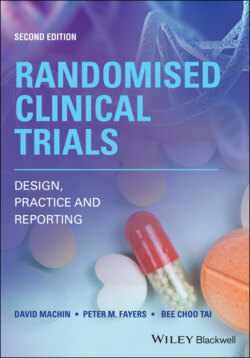Читать книгу Randomised Clinical Trials - David Machin - Страница 134
3.14 Trial forms
ОглавлениеAs we recommended earlier, since recording the patient data is integral to successful trial conduct, inclusion of the trial forms into the protocol itself is often desirable, even when they are quite simple in structure. However, if these are web rather than paper‐based how these are to be presented to any protocol review committee may depend on local circumstances.
The forms should be developed in parallel with the protocol, and may (depending on local regulations) have to be submitted for approval with the trial protocol itself in any event. The number, structure and complexity of the forms required for a trial will be very trial‐specific but, as a minimum, there will be forms containing subject‐specific information relevant to the registration and randomisation process including the intervention assigned, those encapsulating eligibility and other baseline characteristics of those recruited, and a form for the endpoint assessment. In almost all circumstances there will be many more than this and most trials will include special forms for recording details of, for example, any surgical procedures undertaken or unexpected adverse events should they arise.
In general terms, the forms for the clinical trial should focus on essential detail that is necessary to answer the question(s) posed by the design and should not be cluttered with irrelevant items. This focus keeps the clinical teams aware of the key issues and takes them less time than having to record inessential details. Consequently, there are likely to be fewer errors. The completed form also becomes easier to check if there are fewer items and thereby reducing the data management processes and speeding up checking. In this way, any problems remaining can be fed back to the clinical teams more rapidly – which again reduces the workload at the clinical recruiting centre. The briefer the forms, and indeed the simpler the trial procedures, the easier it becomes for collaborators and the more rapidly they are likely to recruit the patients required. But this must be balanced against the need to ensure that the forms do contain all the necessary information that will be required for the analysis. However, the experience of many groups indicates that most trials collect far too much information that is then never analysed nor reported on.
Forms may need to include patient management details, such as the date of the next follow‐up visit, or to confirm if an action has been taken such as the despatch of a laboratory specimen or the completion by the patient of a quality‐of‐life questionnaire. It is best if these are kept to a minimum, and located in a distinct part of the form (perhaps the last items) so that when the forms are received for processing at the trials office these items can easily be distinguished from variables that must be included in the trial database.
